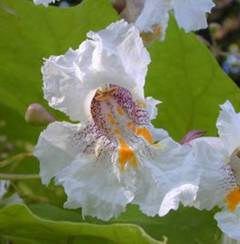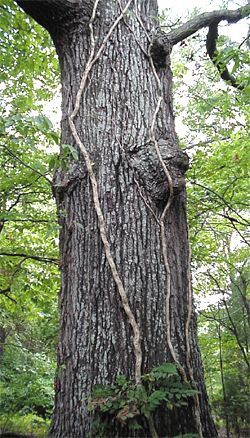|
|
|||
|
THIS WEEK at HILTON POND |
|
After a short vacation at the Carolina coast a few weeks ago, we returned to Hilton Pond Center and an amazing sight: the greatest profusion of Trumpet Creeper blossoms we had ever seen locally--a phenomenon that continues this week and shows no signs of abating. We've written about Trumpet Creeper before, but this year's especially intense bloom makes it worth mentioning again.  Trumpet Creeper, Campsis radicans, is a "hummingbird magnet." Its 2"-3" tubular orange-red flowers are perfectly adapted to fit the long, straight bill of the Ruby-throated Hummingbird, and vice versa. This spring and summer, folks have complained more than usual about a relative dearth of ruby-throats at their feeders; we suspect the supposedly smaller numbers could be due at least in part to a bumper crop of Trumpet Creeper and other flowering plants that bear heavy nectar loads. After all, why should we expect hummingbirds to visit sugar water feeders when there's a diversity of wild blossoms from which to drink daily-fresh nectar and pluck tiny insects? It's interesting that our Hilton Pond Trumpet Creepers have done so well so far, especially with 2002 turning into yet another drought year. Since Trumpet Creeper produces blooms on this year's twig growth, it may be that the recent mild winter and timely spring rains influenced this summer's spectacular bloom enough to override the current scarcity of rainfall. Trumpet Creeper, found across much of the eastern half of the U.S, is a semi-woody vine with compound leaves. Like all viny plants, it is unable to support itself vertically and trails along the ground until contacting a tree or fence post. Then its stems produce tiny rootlets (below right) that adhere to bark or other rough surfaces and allow the vine to climb skyward. Trumpet Creeper clings tightly to the tree, but never wraps around the trunk or chokes it--unlike strangling vines such as Japanese Honeysuckle or Wisteria. Trumpet Creeper continues to grow higher and higher in large trees (or on wooden power poles), constantly reaching toward sunlight blocked by the canopy (above left). Trumpet Creeper also grows as a semi-shrub and forms thickets up to about five feet in height before toppling over on itself. That's the situation outside the farmhouse window at Hilton Pond Center, where a 30' x 50' near-monoculture of Trumpet Creeper produces thousands of orange blooms each season (bottom photo). It is such persistent, dense growth that some gardeners don't like, so we recommend that folks plant Trumpet Creeper on a fence and whack back the vegetation each fall if things get out of hand. Trumpet Creeper is in the Bignoniaceae, the same family as the Southern Catalpa tree, Catalpa bignonioides. Flower anatomy is the principal tool by which plant relationships are determined by botanists, and a head-on look at the flowers of Catalpa (below left) and Trumpet Creeper will reveal--despite color differences--two strong similarities: the five asymmetric petals fused into a tube, and the reproductive structures positioned inside the tube opening's top lip.  . . In the case of the Trumpet Creeper, it's not coincidental that these reproductive structures--the pollen-bearing stamens and sticky pistil--are perfectly situated to hit the forehead of a hummingbird that pokes its bill deep into the flower in search of nectar; this--as we all know from our in-depth understanding of the "birds and the bees"--provides an efficient means of pollen transfer from one Trumpet Creeper blossom to another. Small Trumpet Creeper specimens can be propagated easily by transplanting or, if you like the challenge, by sowing seeds harvested from a cigar-shaped pod that is another structure the vine has in common with the Catalpa tree. In natural circumstances, the pod pops open and releases flat seeds that are carried far and wide by the wind. Gardeners have found that some individual Trumpet Creeper plants can take up to six years or so before blooming, so patience is required; in the meantime, the vines have nice dark green foliage. In our opinion, if you install only one plant to attract Ruby-throated Hummingbirds, it ought to be Trumpet Creeper. It's a native plant that has nurtured countless generations of hummingbirds, and one that should be encouraged in schoolyard and neighborhood Hummingbird Habitats. Trumpet Creeper is often pollinated by bumblebees and other insects and could get along just fine without hummingbirds, but we suspect a sudden extinction of Trumpet Creeper would not bode well for ruby-throats that visit its profuse orange blossoms from May through September at Hilton Pond Center.  If you enjoy "This Week at Hilton Pond," please help Support Hilton Pond Center for Piedmont Natural History. It's painless, and YOU can make a difference! You may wish to consult our Index of all nature topics covered since February 2000. |

 (Regardless, keep your sugar water fresh and wait for the inevitable increase in hummer numbers as this year's youngsters fledge; they'll soon start sticking their bills into such strange places as plastic feeders!)
(Regardless, keep your sugar water fresh and wait for the inevitable increase in hummer numbers as this year's youngsters fledge; they'll soon start sticking their bills into such strange places as plastic feeders!) Some old Trumpet Creeper vines can be 60 feet tall and nearly a foot in diameter, rivaling the girth of the tree to which they are attached.
Some old Trumpet Creeper vines can be 60 feet tall and nearly a foot in diameter, rivaling the girth of the tree to which they are attached.
